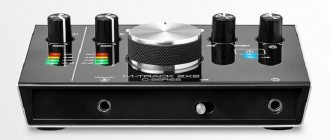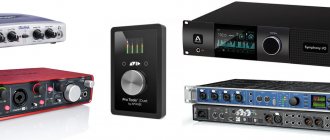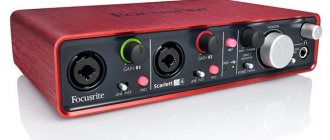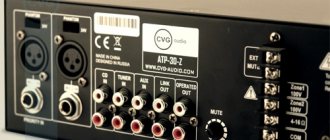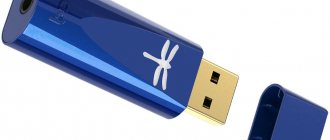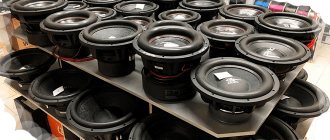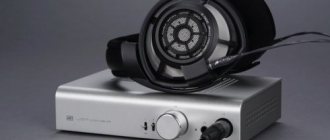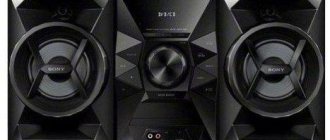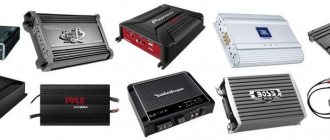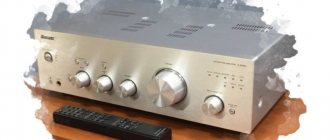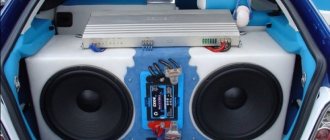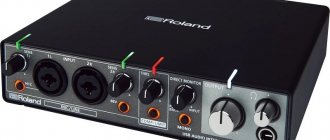Best Budget Internal Sound Cards
The internal sound card is inserted into a free PCI-E slot, does not take up space on the desk and does not require separate power. Speakers or a headset are connected to the rear wall; connectors can be brought out to the front panel through the header.
Disadvantages - you need a free PCI slot, or even two, the solution is only suitable for desktop cases; you can’t plug it into a laptop.
Competing for the title of “best budget sound card for PC” are ASUS and Creative, the creators of the very first Sound Blaster, head and shoulders above. Price restrictions affected the variety of ports, the quality of chips and the transfer of calculations to the program.
3ASUS Xonar DGX
Functionality 8 Cost 9 Reliability 8
The overall score is calculated as the average value of the sum of the main parameters.
8.3 Evaluation
pros
- Inexpensive upgrade to onboard audio
- Headphone Amplifier
- Small card sizes
Minuses
- Audio effects are software, drivers required
- Software errors
- Program setup required
The Taiwanese are targeting Xonar at players - a driver with GX 2.5 effects. The card is low profile (170x64 mm) - it fits in a cheap slim case and plugs into PCI-E.
On the rear panel there is a quartet of mini-jacks: 3 outputs to a 5.1 system, a microphone input in the same jack as a line one, and an optical output. Front connectors can be connected to pins on the card. There is a separate amplifier for headphones, which increases the detail of the sound picture.
The DACs have sufficient bit depth - 24 bits with a frequency of 96 kHz and a good signal-to-noise ratio - 105 dB. The card plays better than the built-in audio, but not fantastic.
2Creative Sound Blaster Audigy Fx
Functionality 7 Cost 10 Reliability 9
The overall score is calculated as the average value of the sum of the main parameters.
8.7 Evaluation
pros
- Good price/quality ratio
- Great headphone amplifier
- Flexible, convenient program
Minuses
- No optical output
- There may be interference from the power supply
- Low output level
Usually Realtec codecs are built into the motherboard, here the ALC898 sound processor is used for the PCI-E card. A short and low black board (126x70 mm) will fit into any system unit.
Three colored 3.5 mm jacks on the rear hardware are responsible for 5.1 audio output, and another pair are separate microphone and line inputs. Inside there is a high-quality headphone amplifier MAX97220A, capable of driving powerful monitors.
The DAC with typical 24-bit/96 kHz parameters provides a signal/noise level of 106 dB, which is very good. An intelligent control program allows you to configure 3D effects for games (EAX 5.0) and significantly improve the sound of your computer.
1Creative Sound Blaster Audigy Rx
Functionality 9 Cost 7 Reliability 8
The overall score is calculated as the average value of the sum of the main parameters.
8.0Rating
pros
- Good sound to replace the built-in one
- Detailed sound picture in games
- High-quality assembly and element base
Minuses
- Overpayment for gilding and karaoke
- Not suitable for micro-ATX cases
- Bad default driver settings
Externally, the PCI-E sound blaster looks amazing - thick black full-profile PCB (139x 110 mm), Japanese capacitors and gold-plated connectors. But the color of the sockets does not differ and the card will not fit into the thin case.
The rear panel is fully occupied - an optical output, 7.1 sound distribution, a line input and two microphones (hello to karaoke fans). The board has a high-quality MAX97220A headphone amplifier.
It is based on the Creative E-MU codec and the Cirrus Logic CS4382-KQZ DAC, which together provide a good signal-to-noise ratio of 106 dB, support for ASIO2.0 (direct access of software to hardware) and EAX 4.0 (effects for games).
When configured correctly, the sound becomes voluminous, and birdsong can be heard in games.
The best internal sound cards in the mid-range segment
The best sound cards for computers in the mid-range segment are also made by ASUS and Creative - these full-profile boards look beautiful, are aimed at gamers and decorators - they have backlighting. There are many more channels and ports, optical outputs and surround sound up to 7.1 are supported. Signal processing is not done in software, but within a separate DSP.
MAYA was also noted here; this card is a semi-professional mixer with microphone and guitar inputs, a monitor channel and fully software control.
3Creative Sound Blaster Zx
Functionality 9 Cost 8 Reliability 9
The overall score is calculated as the average value of the sum of the main parameters.
8.7 Evaluation
pros
- Control panel - connectors at hand
- Versatile sound for games and movies
- Simple and quick program setup
Minuses
- Switching headphones/speakers only by software
- The remote controls the volume of the headphones only
- Backlight won't turn off
A square-shaped full-profile PCI-E card (125x125 mm) will appeal to modders - black PCB under a red casing, with a chip illuminated by a diode visible in the window.
Two of the five 3.5 mm gold connectors are for microphone and headphones, three are for 5.1 speakers, and there are also two optics - S/PDIF input and Toslink output. The box contains a red and black wired remote control with a volume dial, and paired microphone and headphone jacks (3.5 / 6.3).
The system is built on a Creative CA0132 chip, for the front channels there is a separate CS4398 DAC, there are op-amps at the outputs of the speakers and headphones, the signal-to-noise ratio is at a height of 116 dB.
The card sounds great in games and is suitable for music and movies.
2ASUS Xonar HDAV1.3 Deluxe
Functionality 9 Cost 9 Reliability 8
The overall score is calculated as the average value of the sum of the main parameters.
8.7 Evaluation
pros
- AV amplifier 7.1 inexpensive
- Great surround sound
- Flexible software settings
Minuses
- Inconvenient software interface
- You need to buy good speakers and cables
- Two cards take up a lot of space in the case
At first glance, the PCI-E card resembles a full-profile video card; the HDMI input and output are visible on the back wall; the microcircuits are covered with a matte black casing. This is partly true - the board with 7.1 sound is a ready-made AV home theater amplifier.
On the back wall there is a pair of analog RCAs, a coaxial digital output and a microphone jack combined with Toslink optics. Separate DAC and ADC for each channel provide 24-bit/192 kHz conversion with a high signal-to-noise ratio of 120 dB.
Multichannel amplifiers did not fit on one PCB; an additional PCI-E card with six RCA outputs for acoustics was needed. Panoramic sound is excellent in games and movies; in good speakers, every rustle can be heard.
Read on the website: Rating of processors by performance
1ESI MAYA44
Functionality 9 Cost 10 Reliability 9
The overall score is calculated as the average value of the sum of the main parameters.
9.3 Evaluation
pros
- Mini recording studio for pennies
- Universal inputs/outputs
- Visual mixer setup
Minuses
- Doesn't work well with games
- Minor bugs in the software
- Complicated driver setup
The sound card is suitable for beginning musicians; the tall card is inserted into a PCI slot and turns an inexpensive computer into a mixer. The rear plate has four large jacks (6.3 mm) - analog inputs/outputs, as well as digital optical and coaxial inputs. When working with an electret microphone, 48 V phantom power can be supplied, and there is an amplifier for headphones.
The power of the card is revealed in software - the Wolfson WM8776 chip with built-in DAC and ADC (24 bit / 192 kHz) is detected by Windows as three devices, configured in the visual interface, redirecting streams between the microphone, amp, amplifier and monitors.
The sound is live, the conversion quality is between amateur devices and professional instruments.
Which model should you choose?
It is very difficult to give an exact answer to this question. It all depends on your hearing preferences. In this case, some users are delighted with the sound quality of an inexpensive model, while others are not satisfied with an expensive model due to the presence of noise and distortion. You should also take into account the fact for what purpose you are purchasing it. If it is needed to improve the sounds of music or a movie, you should not buy an expensive and professional model that has rich functionality. But budget models are not suitable for game lovers and musicians; with them they will not be able to meet all their needs, for which they need a sound card.
Best Premium Internal Sound Cards
Modern games are an excellent testing ground for debugging new technologies, so the first positions in the top sound cards are occupied by devices for games. Again, ASUS and Creative are noticeable here, only the work of the engineers was carried out at a higher level - the boards were thoughtfully designed, shielded, and expensive converters and amplifiers were used for them.
There are no longer enough narrow strips for multi-channel outputs, so daughter cards with optics and RCA have been added.
This limitation is especially noticeable on the RME studio board - the developers had to take a pair of D-SUBs and connect balanced microphone and guitar inputs to pins.
3ASUS Xonar Essence STX II 7.1
Functionality 8 Cost 8 Reliability 9
The overall score is calculated as the average value of the sum of the main parameters.
8.3 Evaluation
pros
- Low distortion
- High-quality stereo sound for listening to music
- Excellent build
Minuses
- Not recommended for gamers
- Overpriced in Russia
- Crooked and rarely updated drivers
The second generation of the popular Essense series has received many improvements. The tall PCI-E card is carefully routed to reduce noise, the analog circuits are covered with a gray aluminum shield, film capacitors and expensive Muses op-amps are used. All this allowed us to achieve a steep signal-to-noise ratio of 124 dB with only 0.0003% distortion.
For tuning enthusiasts, the amplifiers are supplied with DIP connectors, and the kit includes replaceable microcircuits and pliers. Of the connectors on the bar, there are 2 output tulips, two 6.3 mm inputs (headphones and microphone), coaxial S/PDID. For 7.1 mode, the kit includes a daughter card with RCA speaker outputs.
Stereo sound is excellent for music, provided you have quality speakers or headphones.
2Creative Sound Blaster ZXR
Functionality 9 Cost 8 Reliability 9
The overall score is calculated as the average value of the sum of the main parameters.
8.7 Evaluation
pros
- Great all-around sound
- Rich program settings
- Remote control with microphones
Minuses
- Crowding and heat in the system unit
- The analog resistor on the remote control will crunch
- Need a quality power supply
The long and tall PCI-E card is covered with a black screen with red inserts; a red Sound Core 3D chip is visible in the window. On the golden back wall there are large 1/4″ microphone and headphone jacks - a nod to professionals, as well as RCA outputs and 5.1 surround sound mini-jacks.
The complete daughter card will add two tulips and two optics - input and output. The box also contains a wired remote control with a volume control, paired jacks (3.5/6.3) and built-in stereo microphones.
Serious Texas Instruments converters and Mouser operational amplifiers provide a stunning signal-to-noise ratio of 124 dB.
The card is a universal sound card, suitable for games, movies and enjoying music.
1RME HDSPe AIO
Functionality 10 Cost 7 Reliability 9
The overall score is calculated as the average value of the sum of the main parameters.
8.7 Evaluation
pros
- One card replaces a rack of equipment
- Auto sample rate adjustment
- High sound quality
Minuses
- Possible interference from the computer
- No Russification of programs
- There may be difficulties with installation
A full-profile PCI-E card can hardly be called just an audio card; it is an audio interface that brings together any signal sources in any combination. There are only two optical jacks and a pair of D-SUBs on the metal bar. The 15-pin contacts are converted by cables into balanced analog inputs, professional ADAT, AES/EBU or MIDI interfaces. If necessary, external units are connected, for example, a time synchronizer for recording TV programs.
All ports work simultaneously, the streams are combined by the TotalMix mixer. The ADC is supplied by CS5361, the DAC is AD1852, the bit width is 24 bits, the frequency is 192 kHz - changes automatically. The signal-to-noise ratio reaches 120 dB.
The sound is professional, the board is used in studios.
The best budget external sound cards
The best external sound cards are suitable for outputting music from laptops (to improve the stock sound) or for portable devices like the Raspberry Pi, which do not have expansion slots. Small packages contain an ADC/DAC, sometimes with a simple amplifier, and receive power from a USB port.
The characteristics of the converters are not premium, but they are not required to be high-end.
The rating below shows a card from Creative, as well as a couple of Behringer devices - an inexpensive input for a guitar and an unexpectedly high-quality inexpensive audio system.
3Creative Sound Blaster Play! 3
Functionality 7 Cost 10 Reliability 8
The overall score is calculated as the average value of the sum of the main parameters.
8.3 Evaluation
pros
- Compact dimensions
- USB Powered
- Headset compatibility
Minuses
- Average sound performance
- Noise when recording from a microphone
- No recording gain control
A small black box 2 cm wide and 14 cm long is plugged into USB with a flexible wire protruding from the end; on the other hand, there are 3.5 mm jacks for a microphone and headphones (scheme 2.0), you can also plug in a headset with a 4-pin plug.
Hidden inside are a 24-bit/96 kHz DAC and a 24-bit/48 kHz ADC, as well as an amplifier. The design has an average signal-to-noise ratio of 96 dB, other characteristics are also not great, for example, harmonic distortion is 0.132%.
The quality of the device is slightly better than the integrated sound; it is suitable as a headphone amplifier or a path for the Raspberry Pi.
2BEHRINGER U-PHORIA UM2
Functionality 8 Cost 8 Reliability 8
The overall score is calculated as the average value of the sum of the main parameters.
8.0Rating
pros
- Compact replacement for guitar amp
- Professional connectors
- Balanced input with phantom power
Minuses
- Difficulty finding drivers
- High noise level
- Map for amateur tasks
Aspiring guitarists and entertainers will appreciate the convenience of this audio interface. The black desktop box plugs into USB and collects signals from two inputs in the computer. Each channel has its own level control (on the cover). An electric guitar is connected to a large 6.3 mm jack, the second combo input (XLR/TRS) is balanced for a pickup or microphone, and 48 V phantom power is supplied to the capacitor system. The result can be listened to through headphones or output via RCA to speakers. The DAC converts signals with a frequency of 48 kHz and 24 bits.
1BEHRINGER U-CONTROL UCA222
Functionality 9 Cost 10 Reliability 9
The overall score is calculated as the average value of the sum of the main parameters.
9.3 Evaluation
pros
- Very high quality sound for the price
- Elementary installation, true plug-and-play
- ASIO 2.0 protocol support
Minuses
- The analog volume control rustles
- Cheap plastic slides on the table
- For complete perfection, all devices must be coordinated
A red plastic soap dish in size and appearance resembles a player from the 80s (18x14x4 cm). On the left sticks out a USB tail for communication with a PC and power supply, on top there are RCA stereo inputs and outputs, on the bottom there is an optical output, a mini-jack for monitoring and a black volume wheel protruding from the body.
The internal Burr Brown PCM2902E converter does not have a high bit resolution (16 bits), the maximum sampling frequency is 48 kHz. But the ASIO 2.0 protocol is supported for direct operation of programs with hardware, a rare case for a budget solution.
Despite the modest characteristics, the sound of the card is unexpectedly good, without interference or noise.
comparison table
| Rank/Name | Expert assessment | Price range, rub. |
| The best internal sound cards for a computer | ||
| Creative Audigy Fx | 80 out of 100 | From 3,250 to 4,241 * |
| ASUS Xonar AE | 84 out of 100 | From 3,910 to 4,770 * |
| ASUS Strix Soar | 84 out of 100 | From 6,358 to 9,129 * |
| ESI MAYA44 eX | 88 out of 100 | From 13,530 * |
| Creative Sound Blaster ZXR | 90 out of 100 | From 14,989 to 19,090 * |
| M-Audio Audiophile 192 | 92 out of 100 | From 28,231 * |
| RME HDSPe AES | 96 out of 100 | From 81 372 * |
| The best external sound cards | ||
| BEHRINGER U-CONTROL UCA222 | 80 out of 100 | From 1,801 to 2,274 * |
| FiiO E10K USB DAC | 80 out of 100 | From 5,990 * |
| ASUS Xonar U7 MKII | 84 out of 100 | From 6,479 to 11,462 * |
| Creative Sound BlasterX G5 | 86 out of 100 | From 9,579 to 12,140 * |
| Steinberg UR22mkII | 86 out of 100 | From 12,020 to 13,490 * |
| PreSonus Studio 24c | 88 out of 100 | From 13,986 to 22,621 * |
| Focusrite Scarlett Solo Studio 3rd Gen | 90 out of 100 | From 18,990 to 24,800 * |
| Native Instruments Komplete Audio 6 MkII | 92 out of 100 | From 20,990 * |
| AudioQuest DragonFly Red | 92 out of 100 | From 22,000 to 23,490 * |
| ZOOM R24 | 98 out of 100 | From 37,587 to 49,435 * |
* all prices are valid for February 2022
The best external sound cards in the mid-range segment
The rating of external sound cards for computers continues in the middle price segment. These devices are more functional - they can work as a good sound card (Creative) with the option of digitizing recordings or audio interfaces for an amateur studio or home concerts.
This includes professional connectors, powered microphone inputs, and channels for audio monitoring. The bonus includes software for mixing tracks and support for tablets and smartphones via the same USB port. Professional sound from a tablet? Sounds strong.
3Steinberg UR12
Functionality 9 Cost 10 Reliability 9
The overall score is calculated as the average value of the sum of the main parameters.
9.3 Evaluation
pros
- Great card for your home studio
- Compact heavy body
- CUBASE program included
Minuses
- Windows needs to be configured
- Monitor output for low impedance ears
- No separate headphone volume control
A simple version of the UR12 external audio interface is housed in a compact case (159x144x46 mm). The appearance is austere, as befits sound equipment - black panels, an aluminum casing with rubber supports.
Balanced XLR input - for connecting a microphone, optional 48 V phantom power is supplied, high-impedance HI-Z input (6.3 mm jack) - for electric guitar. The level is adjusted for each port, and monitor ears are plugged in nearby to hear the result. DAC / ADC - Cirrus Logic CS4270 has good parameters 24 bit / 192 kHz, signal noise is a little high - 87 dB.
The device connects to a PC via USB-D, there are RCA stereo outputs to the amplifier, power comes from a computer or power bank via micro-USB.
2Creative X-Fi HD
Functionality 8 Cost 9 Reliability 8
The overall score is calculated as the average value of the sum of the main parameters.
8.3 Evaluation
pros
- Ringingly clear sound for gaming
- Good headphone gain
- Works with Android via OTG
Minuses
- Speakers do not work with headphones
- Legacy mini-USB connector
- Not an audiophile product
The modest black box looks like a media player; on the front panel there are large headphone and microphone jacks (6.3 mm) and a volume control. There is more choice on the rear wall - RCA line output, optical inputs/outputs, mini-USB for PC and power, as well as a line input signed Phono - the manufacturer offers to connect a record player to it for digitizing recordings.
The Creative CA0189-2AG chip works inside; the converters operate at 24 bit/96 kHz with a decent signal-to-noise ratio of 100 dB. The EAX 4.0 surround sound standard for games is supported.
Reviews from owners indicate that the card sings great, but is better suited for games than for music.
1Focusrite Scarlett 2i2
Functionality 10 Cost 9 Reliability 9
The overall score is calculated as the average value of the sum of the main parameters.
9.3 Evaluation
pros
- Nice compact body
- Separate headphone volume control
- Studio sound from a media player is priceless
Minuses
- Doesn't rock headphones well
- No XLR cable included
- Minor difficulties with drivers
Street musicians have at their disposal a compact (45x175x100 mm) device that is beautiful and stylish. Red anodized aluminum, high-gloss volume verniers and overload indicator lights. Powered by 5V via USB-D, connects to PC, tablet or media player.
Universal inputs with combined XLR/TRS jacks will pick up sound from a synthesizer, guitar or microphone (there is phantom power), and output to monitors is via large jacks on the rear panel. Finally, the right thing has been done - the headphone volume is adjusted separately from the monitor volume.
ADC/DAC chips - CS4272 process signals with parameters up to 24 bit/192 kHz. The sound is excellent, consistent with an entry-level professional system.
Audio outputs
We've already looked at audio outputs earlier, but the example we gave is just a drop in the ocean of sound cards.
For example, sound cards can be equipped with the following types of outputs:
The only thing you need to pay attention to is the presence of a line output to which headphones, speakers or monitors are connected.
In simple words, you should ask yourself the question: “ What will I connect to the sound card?
" The answer to this will simplify the choice of sound card.
Interesting fact: there are various adapters from one connector to another, which will allow you to unify some connectors.
For example, Jack 6.35 on XLR or Jack 6.35 on RCA .
Best premium external sound cards
While supporting traditional PC players, manufacturers seem to have forgotten about the whole army of console players playing RPGs, shooters and stealth quests. But for them, the sound is part of the script and is extremely important for victory.
It’s all the more joyful to meet a new product from the Creative team, which opens the top of sound cards with an external connection - the thing clings to the Play Station or Xbox and generates not only realistic sound in the headphones, but also a three-dimensional panorama - now not a single enemy will pass by.
The remaining pieces of hardware are professional inputs that collect signals from sources under the control of the sound engineer.
3Creative Sound BlasterX G6
Functionality 9 Cost 8 Reliability 9
The overall score is calculated as the average value of the sum of the main parameters.
8.7 Evaluation
pros
- A new level of sound for consoles
- Top converter
- Powerful amplifier for any headphones
Minuses
- Fine tuning for Windows only
- Gets hot during operation
- Custom short optical cable
This external sound card is aimed at gamers and can work not only with PCs, but also with consoles. The small case, 70x24x111 mm, weighs 144 g, will not weigh on your pocket or crush your legs.
Ergonomics are top notch - the angular prism is cast in matte metal, between the headphone and microphone jacks there is a ribbed volume knob with RGB backlighting. On the back wall there is a linear input and output, combined with optics, as well as micro-USB. The buttons on the side limit the gain and activate Scout Mode - to better hear the enemy’s steps.
The DAC parameters are simply fantastic - 32 bits with a frequency of up to 384 kHz, distortion - microfractions of a percent. And the amplifiers are assembled using discrete transistors - hello from the High-End world.
2Steinberg UR44
Functionality 9 Cost 7 Reliability 10
The overall score is calculated as the average value of the sum of the main parameters.
8.7 Evaluation
pros
- Many universal inputs
- Two monitor ear outputs
- Separate channel outputs
Minuses
- Aluminum body rings
- Minor difficulties setting up drivers
- Software manufacturer's licensing policy
A steel box with four combi XLR/TRS inputs is suitable for a small musical group and will combine guitar, drums, microphones and a synthesizer into a single track. Each channel has a level control and supplies 48V for condenser microphones. It’s great that there are two monitor outputs - the sound engineer no longer has to share a headphone with the director.
The rear panel has MIDI inputs/outputs (DIN), separate line outputs and master channel, USB-D for computer and external power. Interestingly, the card works with the iPad - it turns out to be a mobile recording studio.
Inside there is a Yamaha YC706A0 processor and high-quality Japanese parts. The sound is professional quality.
Sound quality
The better and higher quality the sound card, the more expensive it is. You have to pay for quality, and therefore we advise you to consider well-known and trusted manufacturers (Line 6, Focusrite, BEHRINGER, M-Audio, etc.).
If you're on a budget, consider purchasing the card secondhand. When purchasing, you should pay attention to the functionality of all inputs, outputs, regulators and switches. There should be no background noise from the sound card when turning the controls (especially the volume control). Appearance, as a rule, does not play a special role.
